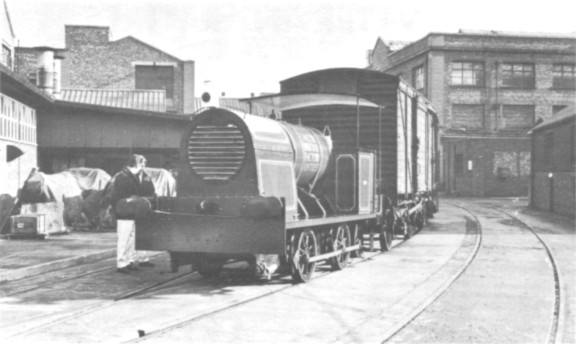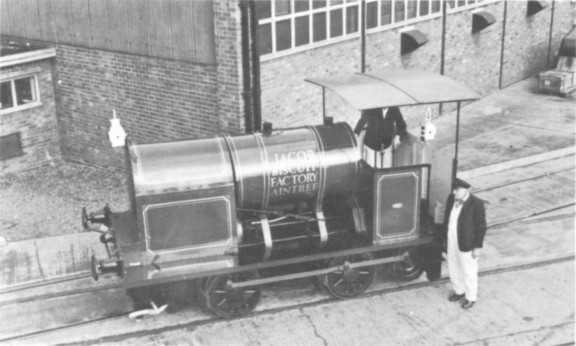
| THE INDUSTRIAL RAILWAY RECORD |
© OCTOBER 1968 |
A VETERAN RETIRES
C. R. WEAVER
The oldest standard gauge petrol locomotive in the World has just retired from active service at the Aintree (Liverpool) Biscuit Factory of W. & R. Jacob & Co Ltd. Fortunately this interesting survival, Baguley Cars Ltd No.680 of 1916, is to be preserved in the proposed Northern Regional Open Air Museum where, it is hoped, it will be a working exhibit.
No.680 was delivered on 21st August 1916 to Richard Johnson & Nephew Ltd of Manchester; although it had the firm's Manchester address on the cabside it is understood to have gone new to an armaments factory at Aintree, which was operated by RJ & N for the Ministry of Munitions. When this activity came to an end the locomotive was sold to Jacob's where until the arrival of a battery loco in 1923, it was the principal locomotive. From 1923, however, it was relegated to spare and saw service only when the regular locomotive was out of commission except for a few weeks in 1927 when it was hired to the Cheshire Lines Committee, The CLC were carrying out some civil engineering work in the vicinity and despite careful instruction, they managed to damage the engine severely. The locomotive was therefore returned to the makers for installation of a new engine which, in view of the duty performed by it, was smaller than the original unit. In this condition No.680 continued as spare locomotive for a further forty years until Jacob's closed their internal rail system in 1967 and began to send out their products in containers by British Railways "Freightliner" services. This was an appropriate move for a firm which had pioneered containers many years before. It was felt that No.680 should not be scrapped in view of its probable historic interest and in due course it was transferred to the Northern Regional Museum whose stock of major items is currently being amassed by the Bowes Museum pending establishment of the permanent museum site.
No.680 was the eleventh locomotive built by Baguley Cars Ltd., but only their second for the standard gauge, being built to the general design of No.566 delivered a month earlier. As was Baguley practise at this time, the works plate reads "Mc Ewan Pratt & Co. Engineers London & Burton". As built, No.680 was a 55/60hp petrol/paraffin locomotive, but since its re-engining in 1927 has run on petrol only and has a 40hp rating. The original engine was a four-cylinder White & Poppe (127mm bore x 180mm stroke) rated at 55hp on paraffin or 60hp on petrol, both at 900rpm. The replacement engine is a four-cylinder Baguley (4¾in x 5½in) developing 40hp at 900rpm. The engine is mounted at the front of the locomotive under the sloping casing and is started by hand, the starting handle being fitted to a cross-shaft behind the buffer beam on the right-hand side. Behind the engine are two large tanks, the front one containing 220 gallons of cooling water and the rear one 100 gallons of fuel. Originally two small tanks of approximately 7 gallons capacity were fitted in the cab, that on the right hand side containing petrol for starting and that on the left additional lubricating oil. These were removed when the Baguley engine was fitted in 1927. A set of sight-feed lubricators on the front sheet supply oil to the transmission bearings. Originally there were two throttles, as the engine had separate carburettors for petrol and paraffin. The single throttle lever retained today bears the legend PARAFFIN as a reminder of the original layout.


Two photographs of BAGULEY 680 taken by Brian Webb on 17th February 1968. Notice cab control levers and the bar preventing the buffers rotating. The regular driver standing beside 680 takes a last look at his charge.
The clutch is operated by the handbrake screw, an arrangement much used by Baguley prior to 1920 (Baguley & Bentall Patent). The reverse gear box is mounted under the footplate and driven by a cardan shaft; the reverse gear is of the usual bevel pattern operated by one of two levers set sideways at the rear of the footplate. The transverse output shaft drives the jackshaft below it by means of spur gears at either end, the gear ratio at one end being twice that at the other. One or other of these gears is engaged by the other lever at the rear of the footplate, the whole forming a simple but effective two-speed transmission. Assuming that the mechanical parts of No.680 were identical with those of No.702 (featured in "The Engineer" of 31st May 1918), the claimed performance was as follows:- Speeds at 900 engine rpm, 3mph in low gear and 6mph in high gear; 90 tons load at 6mph on the level in high gear. I suspect that the makers quoted a load which the locomotive could stop safely, rather than its maximum haulage capacity, although a lot depends on what the 90 ton load consisted of. In its present form No.680 can handle seven vans, a loaded weight of about 80 tons, which compares favourably with its original capabilities.
At my suggestion No.680 made its last run at Aintree on 17th February 1968. In the weeks preceding the event it was most beautifully repainted in maroon with gold lining and lettering, with an original company crest adorning the rear sheet. British Railways loaned two vans for the occasion and the sun appeared over Liverpool, all of which was most gratifying to the small band of enthusiasts who had come many miles to witness the event. No. 680 was formally handed over to its new owners; it left Aintree on 10th September 1968 to be stored at Glossop until the Museum is ready to receive it.
The information in this article has been obtained from the records of Baguley Cars Ltd., by permission of Mr W. R. Souster, Managing Director, Baguley-Drewry Ltd, and from W. & R. Jacob Co Ltd, through Mr A. P. James. I would also like to thank Mr James for the arrangement leading up to the "last run" of February 17th.
For the record....
"Near Somerford Magna …….. the station which is being rapidly erected by Messrs Brock and Bruce was surrounded by several choice specimens of the Wiltshire peasantry who express their wonderment at the engine and attendant carriages."
Paragraph describing the opening on 17th December 1877, of the Malmesbury Railway from Dauntsey to Malmesbury ('Bristol Evening News : 18th December 1877. - C. G. D.)
"As the early train was proceeding from Dauntsey, the gatekeeper failed to open the gates and the train dashed through, shivering them to atoms From inquiries it appears that the old man at the gates could not get out of the house in time owing to the handle of the door coming off in his hand."
Accident on the Malmesbury Railway. 18th December 1877. ('Bristol Evening News'. 19th of December 1877. - C.G.D.)